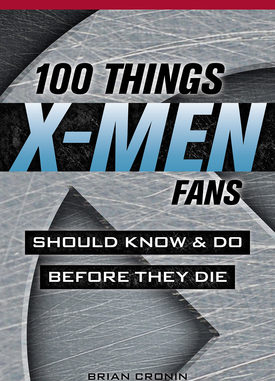
Whenever a compendium comes out about the X-Men, as a fan the first thing you may do is look at the table of contents. You can tell if the reference book is just retreading the same ground or if there are nuggets of revelations that can be found in the chapters featuring Wolverine or Jean Grey. That said, ‘100 Things X-Men Fans Should Know and Do Before They Die’ by Brian Cronin is not for the diehard X-Men fan.
Think about Wolverine. Cronin does introduce when James Howlett is classified as a mutant and the first time his healing factor is brought to the forefront in a clear manner. However, it’s done in spurts. There’s no consistency. Eventually you learn everything about Wolverine, but you must go through the entire book to do so. It’s problematic for a longtime fan and maybe perplexing for the casual reader. What’s also confusing are the creators, writers, artists and directors who have shaped the X-Men mythos. They are also all over the place.
An index would be helpful to find where writers such as Chris Claremont are featured other than the four-page chapter that bears his name. Claremont, like Wolverine forms a thread throughout each chapter. But his influence on the X-Men is not in chronological order. Rather, Claremont’s contribution seems to be lined up in a way that would frustrate anyone who would want to know and understand just how influential he was to establishing the things we know now of the diametrically opposed philosophies of Xavier and Magneto that has become canon in both the comics and films. Having Claremont in chapter three, then again in chapter 49 lacks consideration to the reader. Why not have a streamlined format where Claremont is discussed fully and comprehensively, instead of the repetition found throughout this reference book. There are some good bits to Cronin’s book. One bright spot is his comprehensive history of Storm. It’s chronologically clear and consistent.
There are those who remember the ‘Uncanny X-Men’ issue 186 in which Forge, feeling remorseful for stripping Storm of her mutant abilities, takes her to Dallas to help her. That is the part of this complicated team called the X-Men. At times teammates at others foes, their narratives are constantly evolving. That particular issue showed two people trying to understand each other. The complexity of the X-Men can be seen in that comic which came out in 1984. Storm attempts to reconcile losing her power, Forge revealing that he has an artificial leg and arm due to the Vietnam War show multiple levels of complexity that isn’t seen in Cronin’s assessment of the X-Men. For the reader there doesn’t seem to be enough depth or analysis that the title of the book promises.
Overall if you know nothing of the X-Men, you may find Cronin’s book a way in without having to have seen every animation, movie and read every comic-book. Still, it’s not for everyone.

Leave a Reply